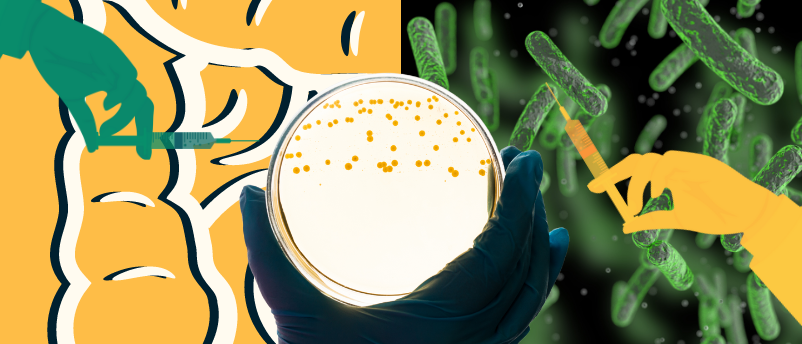
BioTechniques News
Beatrice Bowlby

“Delivery of therapeutic molecules is a major bottleneck for medicine, and we will need a deep bench of options to get these powerful new therapies into the right cells in the body,” commented Feng Zhang, an Associate Professor at MIT (MA, USA) who’s research group recently published a paper on a bacterial injection system.
Our Assistant Editors, Beatrice Bowlby and Aisha Al-Janabi, wrote about two different research groups that have harnessed natural bacterial systems and their syringe-like machinery to deliver therapeutic payloads, one focusing on delivering antibodies to the gut and another on protein delivery to different cell types.
Smart microbes: an alternative drug delivery system
A recent study genetically modified gut bacteria to enhance their intrinsic therapeutic properties.
Researchers at Massachusetts General Hospital (MA, USA) have harnessed gut bacteria’s natural therapeutic properties by genetically modifying them to deliver nanobodies to combat intestinal infections and cancer. Additionally, this form of treatment limits the adverse reactions commonly associated with other systemic drugs and their administration. [1, 2]
A wide range of gut bacteria is an important part of human health, performing numerous essential functions. Due to a growing need for alternative drug delivery methods, the researchers of this study wanted to enhance the beneficial properties of a common microbe, probiotic Escherichia coli (E. coli), to be able to deliver targeted treatment.
So, how did the researchers engineer these smart microbes?
 Connecting the dots between HPV, the vaginal microbiome and race
Connecting the dots between HPV, the vaginal microbiome and race
We spoke to Kathy Tossas about the complexity of the vaginal microbiome and how lived experiences, such as racism, impact it.
Due to the microbes’ outer envelope making protein transport difficult, the researchers’ biggest challenge was working out how to reengineer beneficial E. coli’s protein secretion systems to work therapeutically. “Many pathogenic relatives of E. coli directly transport bacterial proteins across their outer envelope into human cells using a syringe-like machine,” reported senior author Cammie Lesser.
The team has been studying this mechanism for years and has now engineered a probiotic E. coli strain, Nissle 1917, to contain the syringe-like secretion machinery for the therapeutic delivery of a range of proteins. This programmable E. coli, called PROT3EcT, was then tested in mouse models of inflammatory bowel disease.
They found that PROT3EcT programmed to secrete anti-inflammatory nanobodies were as effective as an injected monoclonal antibody that targeted the same cytokine, tumor necrosis factor (TNF) alpha. However, systemic drug delivery of antibodies that neutralize TNF alpha results in general immune suppression, a side effect that may be able to be bypassed using engineered bacteria.
“Patients administered these drugs systemically are at risk for developing life-threatening infections as well as lymphoma,” commented Lesser. “By using engineered bacteria, it should be possible to deliver these anti-inflammatory antibodies and limit immunosuppression directly to where inflammation is present.”
They plan to increase the range of bacterial strains that can be programmed to secrete therapeutic antibodies, with the hopes that they will soon be able to target specific conditions, such as cancer and intestinal infections like colitis.
Bacterial ‘syringe’ offers novel biomolecular delivery system
Researchers repurpose a syringe-like structure in symbiotic bacteria for programmable protein delivery in human cells.
A collaboration between researchers at the Broad Institute of MIT and Harvard and the McGovern Institute for Brain Research (MA, USA) has developed a novel protein delivery system by reengineering nanostructures found in symbiotic bacteria to deliver a range of proteins to human cells and cells in live mice. This technology could lead to a safe and efficient method of delivery for gene therapies and cancer therapeutics, for example. [3, 4]
To enhance their ability to survive, symbiotic bacteria adjust the biology of their surroundings using a syringe-like structure, which is around 100 nanometers long, to inject proteins into host cells. This is called an extracellular contractile injection system (eCIS) and consists of a rigid tube within a sheath that contracts to pierce the cell membrane and force its protein cargo into the cell.
One end of the eCIS has tail fibers to recognize specific receptors on the cell surface, which it can latch on to. Previous research has found that eCISs naturally target insect and mouse cells, raising the question: could this system be tailored for therapeutic protein delivery?
 The future of lipid nanoparticles and mRNA cancer vaccines
The future of lipid nanoparticles and mRNA cancer vaccines
Messenger RNA (mRNA) vaccines would not have been possible without breakthroughs in lipid nanoparticles, both of which researchers are now developing for cancer therapeutics.
The researchers of this study utilized AlphaFold to redesign the machinery, including the tail fibers and binding domain, to target human cells and deliver a protein of their choosing. They focused on the Photorhabdus virulence cassette (PVC), an eCIS secreted by the Photorhabdus bacteria.
“By learning from how nature transports proteins, we were able to develop a new platform that can help address this gap,” commented Zhang.
The researchers designed the PVC to deliver a variety of proteins, including base editor proteins, proteins that are toxic to cancer cells and Cas9, to human cells, reporting functional delivery and high efficiency. Additionally, they used it to deliver proteins to the brains of live mice, which did not induce a detectable immune response. These results indicate that PVCs could be used for programmable protein delivery devices in the future.
To demonstrate how this can be used, researchers tailored a PVC to target cancer cells expressing the epidermal growth factor receptor. The researchers found that almost all cells with this receptor were killed, leaving cells without it unharmed.
The researchers added that their specific and efficient biomolecular delivery system could be engineered to deliver different cargo, like DNA or RNA.
“This is a really beautiful example of how protein engineering can alter the biological activity of a natural system,” commented Joseph Kreitz (Broad Institute of MIT and Harvard), the first author of the study. “I think it substantiates protein engineering as a useful tool in bioengineering and the development of new therapeutic systems.”
The post Bacteria provide inspiration for novel therapeutic delivery approaches appeared first on BioTechniques.
Full BioTechniques Article here
Powered by WPeMatico
